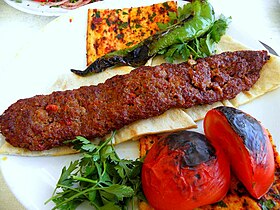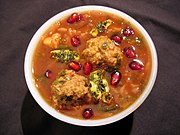Kebab

Jūjeh kabāb, roast chicken kebab in Iran, with vegetable skewers
|
|
| Course | Main course |
|---|---|
| Place of origin | Middle East |
| Region or state | Asia, the Balkans, the Middle East, North Africa |
| Serving temperature | Hot |
| Main ingredients | Meat |

Turkish Adana kebabı, lamb kebab with charred peppers and tomatoes, an onion-sumac-parsley salad, and lavaş
Kebabs (also kabobs or kababs) are various cooked meat dishes, with their origins in Middle Eastern cuisine. Many variants are popular throughout Asia, and around the world.
In Indian English[1] and in the languages of the Middle East, other parts of Asia, and the Muslim world, kebab is a broad term covering a wide variety of grilled meat dishes.[2] Although kebabs are often cooked on a skewer, many types of kebab are not.[3]Kebab dishes can consist of cut up or ground meat or seafood, sometimes with fruits and vegetables; cooked on a skewer over a fire, or like a hamburger on a grill, baked in a pan in an oven, or as a stew; and served with various accompaniments according to each recipe. The traditional meat for kebabs is most often mutton or lamb, but regional recipes may include beef, goat, chicken, fish, or more rarely due to religious prohibitions, pork.
In most majority English-speaking countries, two of the most prevalent and familiar kebab dishes are shish kebab and doner kebab. Either of these are often simply referred to as a “kebab” in English.
History
Evidence of hominin use of fire and cooking in the Middle East dates back as far as 790,000 years,[4] and prehistoric hearths, earth ovens, and burnt animal bones were spread across Europe and the Middle East by at least 250,000 years ago.[5] In ancient times, Homer in the Iliad (1.465) mentions pieces of meat roasted on spits (ὀβελός),[6][7][8] and excavations in Santorini unearthed stone supports for skewers used before the 17th century BC.[9]
Kebab dishes originated in the medieval kitchens of Persia and Turkey.[2] They were generally made with smaller chunks or slices of meat, or ground meat, often cooked on skewers over a fire. This cooking method has a long history in the region, where it would be practical in cities where small cuts of meat were available in butchers’ shops, and where fuel for cooking was relatively scarce, compared to Europe, where extensive forests enabled farmers to roast large cuts of meat whole.[10]
The word kebab came to English in the late 17th century, from the Arabic: كَبَاب (kabāb), partly through Urdu, Persian and Turkish.[11] In Persian, the word is borrowed from Arabic.[12] According to Sevan Nişanyan, an etymologist of the Turkish language, the Turkish word kebapis also derived from the Arabic word kabāb, meaning roasted meat.[13] However, it is not often found in early medieval Arabic books, and only became commonly used in relation to cooking in the Turkish period.[10]
The word was first mentioned in a Turkish script of Kyssa-i Yusuf in 1377, which is the oldest known Turkish source where kebab is mentioned as a food.[citation needed] However, Nişanyan states that the word has the equivalent meaning of “frying/burning” with “kabābu” in the old Akkadian language, and “kbabā/כבבא” in Aramaic.[13] The American Heritage Dictionary also gives a probable East Semitic root origin with the meaning of “burn”, “char”, or “roast”, from the Aramaic and Akkadian.[14] These words point to an origin in the prehistoric Proto-Afroasiatic language: *kab-, to burn or roast.[15]
According to Ibn Battuta, a Moroccan traveller, in India, kebab was served in the royal houses during the Delhi Sultanate period(1206-1526 AD), and even commoners would enjoy it for breakfast with naan.[16]
From Wikipedia, the free encyclopedia






















